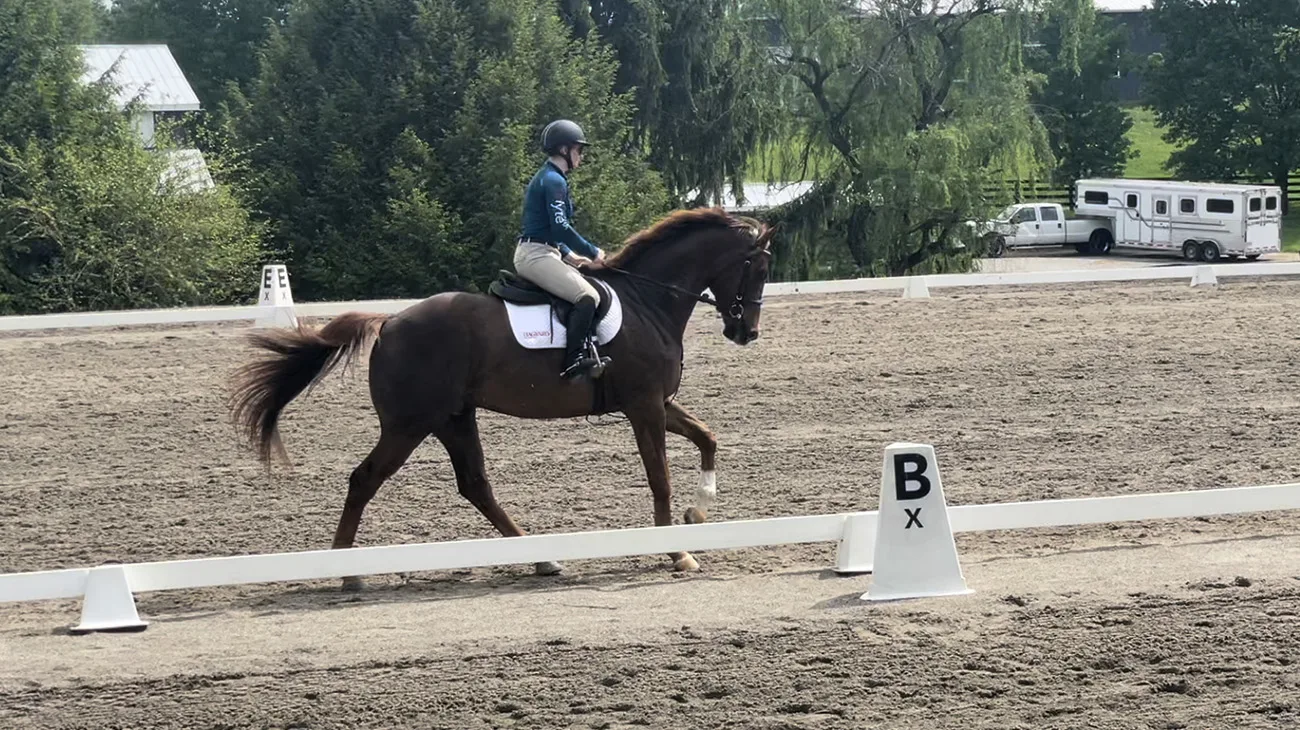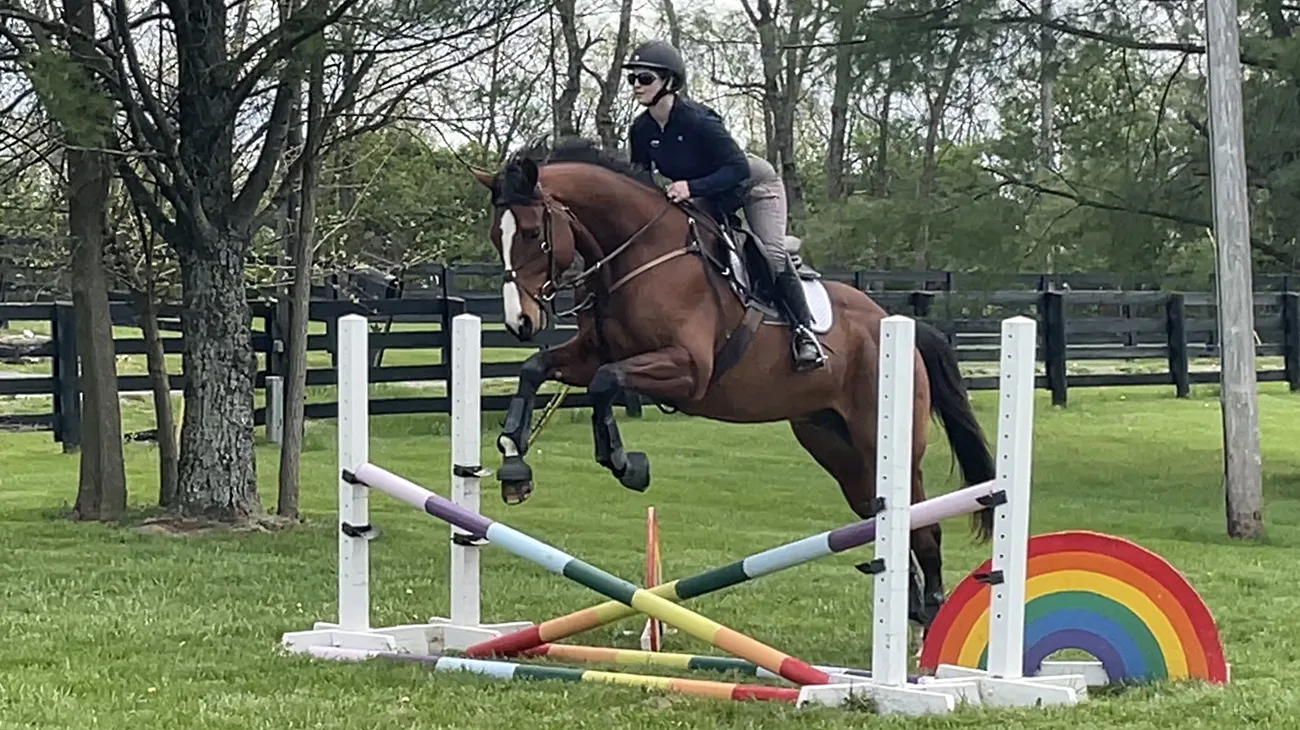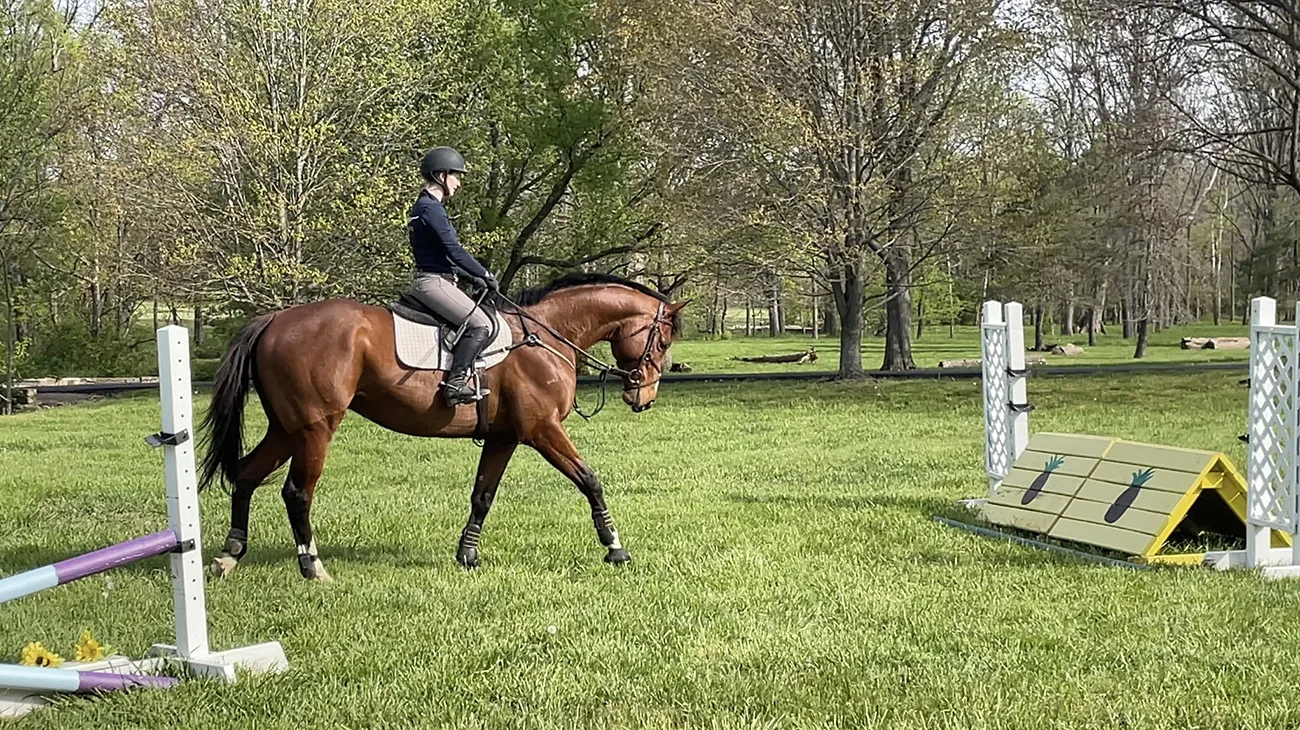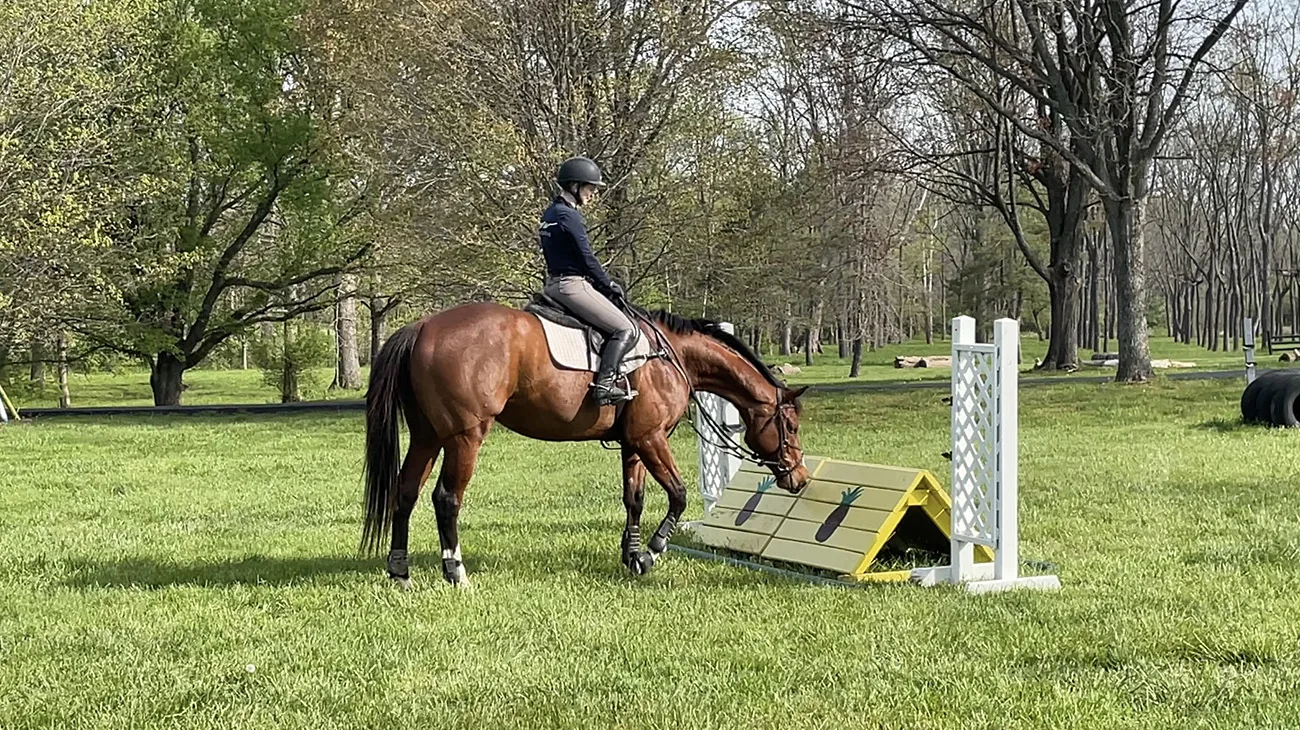As expected, there is an incredible amount to share about the training of my two Retired Racehorse Project Thoroughbred Makeover hopefuls from the past month! When looking back through my videos to see what we’ve done, it’s hard to believe how much happens in such a short time with green horses. How did we get from having jumped a couple of times to competing beginner novice at a mini horse trials?
Gaining Experience
Hank went to two shows leading up to his eventing debut. His first show was back in September when he competed in-hand in a Young Event Horse class at the Flying Cross Farm Horse Trails in Goshen, Kentucky. He’d been such a puppy dog at home that I was hoping the show atmosphere would wake him up enough to show off his impressive athleticism. It did not. He was just so incredibly quiet that he looked better suited to be competing in a class for prospective hunters, following me around with his nose near the sand, ears flopping sideways, and toes just about dragging the ground. In the end though, he was crowned the winner of his two-horse division.
Six months later, both Sam and Hank went to our local Snowbird schooling dressage show at the beginning of March. However, Hank was a completely different horse than at his first show and never made it into the arena.

It was during the time of the aforementioned troubleshooting I mentioned in my last blog, which is also a testament to how quickly and often things can and do change when training young horses. Hank is and always has been mechanically simple to ride, but creating a partnership required more attention. I entered the show confident it would be the perfect first experience for both horses. For Sam it was. Hank was a little further behind in training because he’d gone back to groundwork, but since he was entered, he went.
It would have been easy to decide Hank wasn’t ready to perform a walk/trot test and not take him to the dressage show, but in my experience, there is always something to learn. Sometimes it’s for me to learn about my horse or horses in general, sometimes for the horse to learn something valuable or just gain experience in general. As long as I don’t expect the experience to affect the horse negatively, the horse gets on the trailer.
Hank loaded on my trailer—a process that isn’t seamless quite yet—sat on the trailer for a while, experienced other horses unloading and leaving the trailer, being tied and tacked at the trailer, hacking around the Kentucky Horse Park, and warming up in a strange ring with other horses. All of these were new to him.
In the warm-up, Hank was excited and distracted. He was resistant and over-reactive to my aids, though he did not do anything bad. While he finally settled and walked, he never completely overcame the stimulation of the atmosphere. There was no real point in adding a new challenge like moving away from the other horses in warm-up to go alone into the dressage ring, which he has never seen before, and display his over-reactiveness for the judge. Instead, we schooled for about 20 minutes until he was as settled as I thought he would get, and then we went back to the trailer. The experience was neither a success nor a failure. It was simply an experience for him.
It also let me learn more about Hank: I saw a new side to him, which had been starting to emerge at home, so it wasn’t really a surprise. The positives were all the other things that he did well, like standing on the trailer and being completely perfect other than when he was in the warm-up arena. We keep calm, and we train on.
Respecting Thresholds
I continued to work with Hank in short flatwork sessions that slowly became just walking into the arena, doing some positive work in walk, trot and canter, and then being done while Hank is still working with me as a partner. I’m always sure to keep Hank well inside of his threshold, which of course continues to get broader. By threshold, I mean the point when a young horse is mentally done for the day. The fun part is that as he’s learned how to move a little differently, stretching over his back and holding his own balance, he’s figured out that it actually feels better. He’s clearly starting to enjoy it and hold himself accountable for what and how his body moves.
As Hank came around to seeing his rider as a partner, he got to finally catch up with the jumping. He started with small crossrails in our jump field, adding one fence at a time until he was jumping small, uncomplicated courses. He clearly enjoys jumping and thinks he’s quite good at it.
ADVERTISEMENT
Hank naturally holds a good rhythm, is naturally scopey and has great jumping form, so he didn’t need lots of ground poles to show him where to put his feet. His challenge is staying engaged. He’s the type of horse that may jump 3’ over a crossrail, but after he’s seen it a few times he’s tripping because it gets boring quickly. This is a good problem to have, but it becomes a bit tedious because repetition is how we train. To solve this, we made the jump different almost every time he jumped it by using fillers, different placing poles, V-poles, etc.
Handling Curveballs
Hank did throw a curveball at us when he ran out in a simple line of two crossrails set three strides apart. The first time through, he jumped in crooked, and I was sure it was just landing out of balance that caused him to run out of the second jump. I realized after jumping it a second time that Hank was approaching his threshold for training that day, and Sam was standing 20 feet away by the exit. So the herd-bound, barn-sour version of Hank came back for a hot minute.
We worked through that with repetition until Hank could quietly get to the other side of both crossrails while keeping his focus on me instead of Sam. I consider this situation information for us to file as we move forward. It’s really important to recognize why and where issues like this come up. It’s good for me to know that his run-out had absolutely nothing to do with the jumps themselves.
When a horse is ready for bigger jumps, gymnastics are a great way to introduce new height. In his first gymnastics session, Hank was trotting over four trot poles and then jumping a simple crossrail, 18’ to a vertical, 21’ to an oxer, when things started to get boring. As bold as Hank is, I didn’t think twice about putting a set of barrels into the mix to keep his attention. Well it certainly did—Hank ran out dramatically.
I had created a problem by overestimating his confidence. Helping Hank feel comfortable with the barrels then became priority, which meant unbuilding the gymnastics and focusing on the barrels while also staying conscious that, at this point, we were also coming to Hank’s threshold. We created a positive experience jumping the barrels and ended. The next day I set the barrels on the long side of my indoor and did stretchy flat work around them. At the end of that flat ride, we popped over the barrels. I filed the information and solved “today’s problem.”
It is incredibly important to ride the horse you’re sitting on today and not the horse you were sitting on yesterday, because when it comes to Thoroughbreds, I’m no longer surprised when they start off a ride three steps ahead of where I left off yesterday.
Once the gymnastics had been rectified, Hank started jumping a bit bigger outside and also started jumping all of “the scary stuff”: the fillers.
Introducing ‘Scary Stuff’
To introduce fillers I set very simple crossrails or small verticals/oxers with the fillers there as wings, but not completely outside of the jumps by the standard. Instead, I put them close enough in that the horse will read them when he approaches, but he still feels confident that they’re not in the way.
Next, using an approach I learned from grand prix jumper and trainer Craig Shegog, I’ll jump an easy fence that the horse is familiar with and then approach the jump set with fillers at a trot or canter. About 20 feet in front of the fence, I will transition to walk and walk up to the jump on a long rein, taking my aids off. If the horse stops to look that’s OK. I let him stop but not turn away. I wait for him to give a release like licking and chewing, then ask him to move closer. I do this until he’s completely relaxed standing right in front of the fence and has maybe even put his nose on it. I will repeat this up to five times, depending on the horse, but typically by the third or fourth time they’re basically begging me to let them jump it. Once we do jump it, I’ll repeat that a couple more times until the horse is totally comfortable with it, and then add it into a course.




I find this is a super positive way to show a horse they can trust what you point them at. Sooner or later, they stop questioning you at all, and you have a “yes” horse. When teaching a horse to jump, I typically consider a stop as an indicator of a lack of preparedness (of course there are exceptions) in one way or another. If a horse never has a stop, then he was always completely prepared for what he was asked to jump.
ADVERTISEMENT
I definitely did not have Hank prepared to jump barrels when I randomly threw those into a gymnastic. Every time I make a mistake, I get better at sticking to my process. I love learning, and I always appreciate an opportunity for it. It also gives me more appreciation for my horses being able to overcome my flaws as a trainer. When I think about it that way it seems very simple and relieves me of the pressure. If I prepare my horses properly, everything will be positive. If I make a mistake, I forgive myself because that is how we improve, and I also remember that I’m training a Thoroughbred, and their intelligence and perseverance are not easily paralleled. And that’s what helps me stay confident.
Prioritizing Straightness
Training the class pet, Sam, who is always out to do his best work, is a completely different experience than working with Hank. Being the big baby that Sam is, most of my focus in his flat work is keeping him straight. On the racetrack, horses are taught how to move fast, but there is very little effort made to teach them how to move properly. They commonly need help to keep their haunches in line with their shoulders, but that probably goes for any horse, not just a race horse. Even though Sam is always out to please, he’s still allowed to think he can’t do something until he learns how to do it. He just needs the consistent reminders to keep his body in line and keep moving forward.
Isn’t it ironic that one of the first things we need to teach a fresh OTTB is to move forward? But it is hard, and moving forward while staying straight is especially hard. Showing them haunches-in and shoulder-in (or at least a simple version of it) helps a lot when needing to correct a body part in the trot and canter. I also use turn-on-the-haunches and turn-on-the-forehand as tools. In the canter it’s about getting them to feel the way that they use each hind leg—and they discover that when used symmetrically they feel more balanced, and feeling balanced feels better!
Because good jumping is so dependent on good flatwork, I train with a huge emphasis on just that. Sometimes I have to remind myself to jump. But the more prepared the horses are, the easier it is for them to learn, and the easier it is, the more fun it is for them. One of my guiding principles is to make sure a horse is having fun while doing a job that he didn’t choose for himself.
Sam is more straightforward in general, but he doesn’t naturally jump quite the same way that Hank does. He is as scopey and brave as they come, and he can have fabulous form, but he tends to dive at fences when he is unsure. We use gymnastics and placing poles to help him feel what creates a bascule over the middle of the jump. As we set out into course work, I’ll warm up with all of the “training wheels,” as Dorothy Crowell calls them. Once we’re warmed up and move into a course, I’ll leave a warm-up fence with the training wheels for reference. If Sam tries to help himself over a fence by diving, we go back to the warm-up fence to remind him of where to put his feet in order to jump in the best balance. I will even use a front and back placing rail at 9’ for several jumps on a course until Sam feels confident in how to stay balanced.
Off To The Event
What I have found so important when taking a green horse to a show is to not think about how I want the horse to perform, but how I want to train the horse so that the performance just becomes a reflection of what he’s learned. To be perfectly honest, these horses probably didn’t jump half as much as one might expect before competing at beginner novice. That’s mostly due to Land Rover Kentucky and the Kentucky Derby requiring some of my time and lots of my brain cells during two of the busiest weeks of the year. But they were prepared enough to show up and have a positive experience with one of two dressage tests being quite lovely and only one show jumping rail between the two of them. The fun part though, is guess who came out the star of the show?
Sam warmed up fabulously but became very distracted when the environment changed from being in the warm-up to being alone in the ring and seeing people moving in all different directions at a distance but on all sides of the ring. His response to this was to drop behind my leg, and he actually showed the most herd-bound, sour response I’ve ever seen from him. He was not responsive to my aids in the face of all the extra stimuli, and the test score reflected that. He got the wrong canter lead, and I elected to make an extra circle so that he could get it right, which also added an error to his score. During the test I just kept asking him my normal things, but he looked much different because he was giving evasions instead of the answers he knew I was looking for. As a baby horse, he is completely forgiven for acting like a baby horse. Sam moved on to show jumping and was very good about allowing me to guide him to distances throughout the course, except for one jump where he got distracted and just completely failed to pick his legs up to jump. A fence like that will only make a smart horse better, and he jumped very well throughout the rest of the course, in spite of feeling a little tired at the end.
On cross-country, Sam’s expression said he thought this was the greatest thing in the world. Other than taking some extra time to consider going into the water, his round was seamless. Sam’s show experience is another testament to how often things can and do change for a young horse. Mr. Perfect Pants was just slightly imperfect, which is perfectly fine! Overall Sam learned a LOT and came home in last place but with a positive experience that leaves me confident he will be much more competitive at the next show.
I’ve truly enjoyed the process of creating a partnership with both horses—and all of the horses I ride—but especially with Hank. This show was evidence that Hank has enjoyed it too. He took a bit longer to warm up for dressage but eventually put in some of his best work. When we entered the arena he was also just as distracted as Sam, for all of the same reasons, but Hank stayed completely with me. He even whinnied several times without so much as batting an eye while he did it. He stayed focused on me and tried his best to do what I asked. He did hold some tension which took away from the freedom of his gaits, but it’s safe to say he was well-liked by the judge. In stadium, he kept his antics to a minimum, and I could tell he was just having fun. He listened to every cue I gave him and responded just right to my aids. Hank’s confidence on cross-country was fun for me, and he had an all-around great first event—yet another testament to how often things change when training a young horse.
Rosie Napravnik is a former jockey who holds multiple riding titles throughout the country, is a two-time winner of the Kentucky Oaks, the only female jockey to win multiple Breeder’s Cup races and the only female to ride in all three Triple Crown races. Retired from racing since 2014, Rosie lives in Simpsonville, Kentucky, with her husband, Joe Sharp, and their three children. Rosie runs a private Thoroughbred rehab and retraining operation, Off-Track Sporthorses, from the family’s Four Ponds Farm. Rosie has also created a boutique lesson program for kids, advocating for kids learning more than what an arena has to offer.














